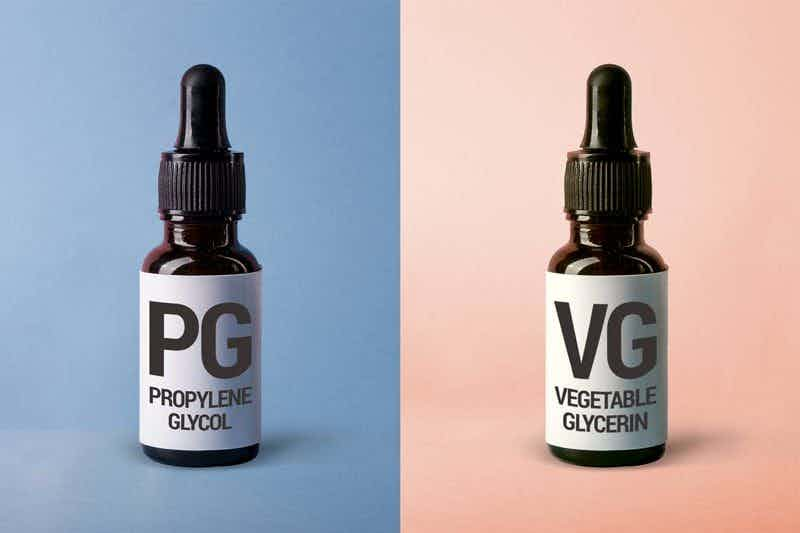VG (Vegetable Glycerin) vs. PG (Propylene Glycol)
What are PG and VG?
In simple terms:
Choosing the wrong PG/VG ratio can put first-timers off so be careful to choose the right level for your equipment.
Now let’s take a look at each in more detail.
PROPYLENE GLYCOL (PG)

What exactly is it?
How is it used?
Propylene Glycol can be found in various common household items. Amongst others, these include:
Is it safe?
Studies have shown that PG is safe to ingest orally, and the FDA has deemed it “generally recognized as safe” to be used as a food additive. However, most studies into the safety of propylene glycol look at ingestion, rather than consuming it in aerosol form. Of the limited studies that exist, a long-term experiment held in 1947 judged that inhaling PG was ‘completely harmless’.
A 2010 study looking at PGEs (a mixture of propylene glycol and glycol ethers) suggested an increased risk of developing respiratory and immune disorders in children, such as asthma, hay fever and eczema. However, it was judged that glycol ethers, and not PG, are the more likely cause. Looking at the evidence, it is sensible to assume that PG is safe to be inhaled, but there is a need for more comprehensive studies to confirm this.
Many misinformed scaremongering stories in the media claim that PG is a toxic substance used in anti-freeze. However, there are two types of anti-freeze: toxic and “non-toxic”. The toxic anti-freeze uses the dangerous substance referred to as ethylene glycol, which is not used in vaping. PG-based anti-freeze is used in food-processing machinery where toxic anti-freeze could be problematic.
While PG is regarded as safe for humans and is generally regarded as safe as a food additive for dogs, it has been linked to Heinz body anemia in cats. Be careful when vaping around cats, particularly if you use PG in your e-liquid.
What should I be aware of when vaping PG?
Some people find a high level of PG irritating to the throat. True allergies to PG are rare, but have been reported. If you find yourself coming out in a rash or suffering other unpleasant reactions after using PG-based e-fluid, you may have a more common mild sensitivity to PG, and should look at using high-VG juice instead. Many vendors offer this option.
The most common side effects of using e-liquid containing propylene glycol are symptoms of dehydration, like dry mouth, sore throat, and increased thirst. It is advised to drink more water and liquids than usual for the first few weeks of using your e-cigarette. If hydrated properly, these symptoms usually last anywhere from a few days to a week as the body gets used to the propylene glycol. Be aware that any unusual reactions could be side effects from quitting smoking, and not necessarily because of the PG.
VEGETABLE GLYCERIN (VG)

What exactly is it?
What is it used for?
Again, it can be found in numerous medical, food and personal care products:
Is it safe?
The FDA has classified VG as “generally recognized as safe” for eating, and it is widely regarded as one of the most benign substances known to man. The SIDS assessment profile show it to have low toxicity when consumed, and low potential to irritate the skin or eye. This, along with the widespread use of VG in food and medicine suggest it is safe for humans. However, as with PG, there are limited studies on VG being inhaled as opposed to ingestion.
A 2008 study of the toxicity of inhaling aerosolized glycerol found minimal risks. We can assume the use of VG in vaping has no serious impact on health but, as with PG, we welcome more detailed studies.
It is important to note that the risk of being allergic to vegetable glycerin is very low, making it a useful alternative for people who have issues when vaping e-juice containing PG. If you are allergic to palm oil or coconut oil then VG could prove a problem, but this is relatively uncommon. Diabetics could possibly experience problems with metabolizing VG, but this would not be an issue at the levels used in vaping.
What should I be aware of when using VG?
The increased thickness of VG means it can reduce the life of atomizers quicker than PG-based juice. High VG liquids clog up coils more rapidly, and will not work well, if at all, in certain tanks. Older products are especially susceptible, particularly models that use smaller coils such as clearomizers. The Nautilus range and eGo tanks are some of the more well-known tanks that are known to have difficulties dealing with high VG fluid.
As with PG, the most common side effects of vaping high VG e-liquid are those of dehydration: dry mouth, sore throat, and increased thirst. Again, be sure to drink plenty of water and take a break from vaping if necessary.

What VG/PG ratio should I use?
There isn’t a one-size-fits-all answer to this. It depends on the kind of vaping experience you prefer. Many people use various levels of PG and VG for different purposes:
What kind of set-up do I need?

It isn’t as simple as deciding on a high VG or PG vape juice and hoping for the best. It all comes down to your equipment. If it isn’t suitable for the job, it can lead to unpleasant throat irritation or wicking problems resulting in dry hits.
Tips for finding your sweet spot
The best way to find your PG/VG ‘sweet spot’ to experiment by making your own e-juice. It’s surprisingly easy to do, and very cost-effective. You can check this out in more detail in our DIY e-liquid guide, but here are some things to be aware of:
Conclusion
The basics of PG and VG are quite easy to grasp. They both work in different ways, and each has advantages and disadvantages. Our advice is to start with a 50-50 PG to VG ratio then try out various combinations and see which you prefer. Make sure your vaping setup can deal with the different ratios.
Many vapers like to use different levels of PG and VG at different times, and with various devices and flavors. Tobaccos, fruits and beverage flavors often go well with PG, as the sharpness of the PG blends well with the tart or fizz of the flavoring. Similarly, flavors based on cream, custard and yogurt tend to work well with high VG as the thick mouth sensation adds to the dessert-like feel. There are no fixed rules, just follow what your taste buds tell you!

Vaping360 Staff


